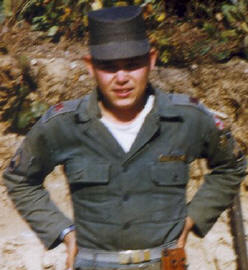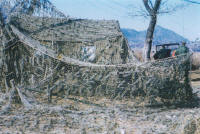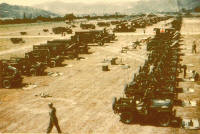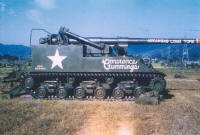|
We need your help to keep the KWE online. This website
runs on outdated technology. We need to migrate this website to a modern
platform, which also will be easier to navigate and maintain. If you value this resource and want to honor our veterans by keeping their stories online
in the future, please donate now.
For more information, click here.
|
|||||||||||||||||||||||||||||||||||||
 |
|||||||||||||||||||||||||||||||||||||
| Back to "Memoirs" Index page | |||||||||||||||||||||||||||||||||||||
|
|
Jimmie L. ClarkChicago, IL- "We came from an era of, ‘It’s your privilege to disagree, but not disobey!" - Jimmie L. Clark
|
||||||||||||||||||||||||||||||||||||
[KWE Note: Jim Clark died November 19, 2004. His obituary is posted at the end of his memoir.]Tour of Duty with the 937th FAB in Korea"Greetings from the President of the United States," was how the letter read advising me to report for military service 14 August 1952. Millions of others and I were being drafted for a period of 24 months active duty with a total of eight years obligation for military service. We came from an era of, "It’s your privilege to disagree, but not disobey!" So off we went to unknown places to serve our country as our leaders suggested. A war had broken out in a land called Korea. It was a country that many of us had never heard of or located on a map. But it was our duty to serve our country. My assignment was to report to Fort Sill, Oklahoma, where I was to attend basic training of eight weeks and then be enrolled in the Field Artillery Replacement Training Center (FARTC) for another eight weeks training as Fire Direction Center personnel. FDC, as it was known, was the hub of the artillery unit. Data was formed and directions were given to send commands to the firing batteries to adjust fire as requested. After completion of the total 16 week course and a ten-day "delay en route" furlough to observe Christmas, I found myself, along with 3200 others, reporting to embark by a military transport ship (MSTS General Brewster) at San Francisco, California, for a 21-day voyage to the Far East. January can find rough seas in the northern part of the Pacific Ocean, and this cruise was no exception. Landfall looked good after 21 days at sea on a crowded transport. After a quick stopover at Camp Drake near Yokohama, Japan, to be fitted with combat gear, the ship arrived at Inchon during a January snowstorm. A journey via rail car and truck eventually got me to my assigned unit. In the IX Corps sector, near Chorwon, defending the "Kansas Line" Main Line of Resistance (MLR), my unit--the 937th Field Artillery Battalion--was in place. The battalion was a federalized National Guard Battalion consisting of twelve M40-155mm gun/self propelled artillery pieces mounted on tank carriages. Four guns with a range of up to 25000 yards were assigned to each of three batteries. With a Headquarters and Service Battery, along with the firing batteries, 35 officers and 400 enlisted personnel operated the battalion. Two officers were assigned as pilots for our L19 observation airplane. Two officers with four enlisted ranks occupied our two observation posts on a rotating basis with 30-day intervals. Our battalion was under the command of IX Corps Artillery, which forwarded commands for fire missions. Because of our self-propelled gun’s mobility, we took assignments from all three US Corps, and made frequent "forward shoots" (hit and run missions close to the enemy using our long range capability). When not on a "forward shoot", we fired regular missions of observed fire from our reinforced firebases. I was a Private E-1 when I was assigned to the Fire Direction Center. In the following months, I served as a radio/telephone operator, Horizontal Control Operator, Vertical Control Operator Computer. I served a month of Observation Post duty, flew two missions as the backseat Air FO in our L19 observation plane, was chief computer, and eventually became Battalion Operation Chief. In February 1954, it became my turn to rotate back to the US and await discharge from active duty. Due to the point system based on combat time, etc., I received an early discharge and returned to civilian life. With military history a hobby of mine, I have researched a particular segment of the Korean War known as "The
Kumsong Salient" (the last major battle of the war 13-20 July 1953), as well as the important role of artillery
and the 937th contribution to that defensive. I gathered the following information on the history and background
of the 937th. |
|||||||||||||||||||||||||||||||||||||
|
|||||||||||||||||||||||||||||||||||||
In 1952, semi-permanent "fire bases" were established for each firing battery, with bunker type emplacements and fortifications constructed. The 937th, being a 155mm self-propelled "long-tom" gun battalion, was used for special missions where heavy long range "fire and move" artillery was needed. The twelve (four pieces per firing battery) tracked artillery pieces frequently road-marched from their reinforced positions to temporary positions extremely close to the Main Line of Resistance. This routine continued throughout the remainder of hostilities.
After several relocations, April 1953 found the battalion in the Chorwon-Kumhwa sector of the central front. The first Korean augmentation soldiers "KATUSAS" (Korean Army Trained by United States Soldiers) arrived and joined the battalion and were assigned to gun crews and wire sections. June 52 the battalion had dug into semi-permanent positions in the IX Corps sector between Chorwon and Kumhwa just south of the Hantan River. The battalion maintained wo observation posts, and Headquarters Battery was established at Chip-o-ri, alongside route 3C. In October, command was transferred to LTC Jerry Dunn, and the battalion prepared to "dig-in" for the winter-spring months ahead. Counter-battery fire was constantly in effect with many "forward shoots" utilizing platoons, as well as the entire battalion, ordered by IX Corps artillery. The Fire Direction Center also directed fire missions to adjoining artillery units such as the 92nd AFA and 424th FAB.
During the next eight months, many hill and outpost battles ensued, especially Pork Chop, Outpost Harry, Jackson Heights, Triangle Hill, Papa-san, Old Baldy, Snipers Ridge, Arrowhead, in the IX Corps sector. During this time much difficulty was experienced with the well-used (almost worn out) artillery pieces and their carriages. Several of the tubes literally "blew-up", causing casualties to the gun crews. Tubes were replaced by older World War II inventory from CONUS arsenals. Other 155mm gun (towed) was substituted when needed. Other types of equipment failures were experienced. In spring 1952, new 12-volt system vehicles replaced the original 6-volt World War II-era inventory. Crystal-type radios were replaced with the new VRQ (FM) system, making radio communications greatly improved. Most personnel experienced five-day Rest and Recuperation leaves.
In the last month of the war, July 1953, the 937th fought its most difficult battle and rose to another height of glory. The Chinese Communist Forces (CCF) tried to seize as much territory as possible before the impending armistice terms were signed. On the night of 13 July 1953, the CCF struck from the Kumsong area (north of UN-controlled Kumhwa) against the Eighth Army line, which was primarily defended by six Republic of Korea (ROK) divisions. The major thrust of the attack was made initially by three Chinese Divisions in a sector where U.S. IX Corps and ROK II Corps boundaries met. The UN front collapsed due to the impact of the drive and a retrograde by the friendly forces of 3rd, 9th, & Capitol ROK Divisions. The CCF reinforced the attack with three more divisions for a total of more than 60,000 troops. The ROK II Corps and the right flank of IX US Corps fell back eight miles before the assault to take positions south of the Kinsong River. Battery "B" was outflanked, and on 15-16 July it had to escape cross-country, which it did without loss of either man or gun—a major achievement considering a 59,000-pound motor carriage of ten-year vintage. The UN forces counterattacked, and on order from Eighth Army Headquarters, stopped the offensive on 20 July 1952. This line of defense was stabilized and the signing of the Armistice went into effect 27 July 1953 at 2200 hours.
After the War
On 30 July LTC Jerry Dunn was replaced by LTC Arthur Gunn, and the Battalion returned to their positions prior to 13 July. In August, preparations were made for the battalion to move all but Service Battery to areas further south of the Demarcation Line. Nothing was to be left in the Demilitarized Zone and all equipment/emplacements/wire/tentage was to be removed and transported. Frequent training schedules went into effect and housing was improved in anticipation of the forthcoming winter in the new positions. Headquarters was put in position along the Main Service Route (MSR3) south of "Kalmal" and north of "Pochon." Command inspection by the IX Corps Commander of the Battalion came in September with the highest rating possible awarded. During the Ordnance segment of the Command inspection, ALL small arms weaponry was considered obsolete and scheduled to be replaced, due to its ten-year usage.
From the end of hostilities until 9 October 1954, the 937th remained in general support of IX U.S. Corps, and trained and stayed honed for battle. On 10 October, it was reduced to zero strength and it was released from active federal service on 26 November 1954. The colors were returned to the state government of Arkansas, and they are now on display at Douglas Armory-Ft. Smith, Arkansas. The 937th is now known as 2B/142nd FAB-ANG. No longer a conventional artillery unit, it is equipped with Guided Missile/Self-Propelled Rocketry.
During the Korean War the 937th officially fired 223,400 rounds on the enemy. It had worn out 65 gun tubes in doing so.
– Jimmie L. Clark, Battalion Operations Chief, 1953-54
National Guard Artillery Units
Participation in the Korean War
At the end of World War II, most non-division artillery was de-mobilized and transferred to the National Guard
and Army Reserve system in the United States. The "War to End All Wars" provided for a peace time reduced size
active duty army to be enforced by a Reserve and National Guard support, as well as a State controlled militia to
be used in emergency. In the artillery units, separate "batteries" would be organized in towns of small size and
areas of larger cities. In many cases these units were called out at the request of each state’s Governor for
emergency and disaster duty as needed. The Federal Government could mobilize these units during the time of
national crisis. The latter was the situation on 25 June 1950 when North Korean Peoples Army forces crossed over a
fully recognized by treaty border known as the 38th Parallel, which divided north and south Korea. Our Department
of Defense urgently needed all available forces to defend that treaty. The peace-time army being so reduced in
size required the activation and mobilization of all available forces. The war effort needed all available
artillery to unite with United Nations Forces to enforce South Korean sovereignty. This call-up of forces included
one particular artillery battalion of the Arkansas National Guard—a 155mm Gun/M40 self-propelled heavy artillery
piece. The battalion, known as the 937th Field Artillery Battalion, was composed of a Headquarters Battery, three
Firing Batteries (A-B-C), and a Service Battery. The personnel, when full strength, was comprised of 37 officers
and 485 enlisted ranks from the towns of Ozark, Mena, Paris, and Fort Smith, Arkansas. After extensive training at
Ft. Hood, Texas, the 937th along with eight other activated National Guard Battalions, arrived in Korea, 2-17
February 1951.
| UNIT | STATE | TYPE ARTILLERY | CORPS |
| 176th AFAB | Pennsylvania | 105mm HOW/SP | I |
| 196th FAB | Tennessee | 155mm HOW/TOWED | X |
| 204th FAB | Utah | 155mm GUN/SP | I |
| 213th AFAB | Utah | 105mm HOW/SP | IX |
| 300th AFAB | Wyoming | 105mm HOW/SP | X |
| 936th FAB | Arkansas | 155mm HOW/TOWED | I |
| 937th FAB | Arkansas | 155mm GUN/SP | IX |
| 955th FAB | New York | 155mm HOW/TOWED | IX |
The original members were rotated after 12 months duty and were replaced by conscripts and regular army personnel until deactivation
937th Field Artillery Battalion
Korea 1950-54
|
|
In August 1953, one month after the truce was signed between the United Nations Command and the People’s Republic of Korea (North Korea), the 937th Field Artillery was ordered by the Commander of the IX Corps Artillery Headquarters to conduct a "Command Inspection of Troops and Equipment." This type of inspection was for the purpose of examining the equipment, efficiency, and readiness of the personnel, as well as to evaluate the unit’s proficiency for battle.
The 937th Field Artillery Battalion scored the highest rating judged by IX Corps Artillery Group of its class (heavy artillery). The battalion had originally been issued World War II equipment, which it still had at this time, with the exception of vehicles ¼ ton (Jeep), ¾ ton (Weapons Carrier), 2½ ton (Truck), and ambulance. Just four months prior, the battalion had transferred from using 6-volt to 12-volt vehicles, and switched their radios from crystal 600s to F.M. type in April, 1953. The original equipment, especially the artillery pieces, was in constant need of repair, and replacement parts were limited. After World War II, the equipment was issued to the National Guard for training purposes, and the government did not foresee its need for combat purposes from 1945 to 1950.
The Battalion was composed of five batteries. (Infantry units were called "companies.") They included Headquarters, "A" (Able), "B" (Baker), "C" (Charlie), and Service. Firing batteries were comprised of four guns each. The commanding officer of the Battalion held the rank of Lieutenant Colonel, and each Battery Commander was a 1st Lieutenant or Captain. Headquarters was assigned a M.D. Surgeon who attended the entire Battalion of approximately 500 troops. Generally, a full strength Battery consisted of 80 enlisted men and 2 officers. Battalion headquarters totaled: 1 Lieutenant Colonel, 2 Majors, 2 captains, 5 Lieutenants, and approximately 90 enlisted men.
|
|
Every heavy artillery unit (155 Howitzer, 155mm gun, 8-inch Howitzer, 8-inch gun, 240mm gun) was a former National Guard unit. Each had its own "nickname" for the unit. The 937th Field Artillery Battalion from the Arkansas National Guard was proudly known as the "Arkansas Long Toms." The 155mm gun (towed or self-propelled) was known in World War II as "Long Toms" due to the longer length of the barrel (tube), which made it more accurate and capable of hitting long range (25000 yards) targets. The code name for the 937th over communication lines was "NEWFORD." A very popular reference throughout the central sector of Korea during the entire campaign of the United Nations forces was, "Get me Newford, Operator,’ or "Here comes the Arkansas Long Toms!"
Chiefs of Section of each had had the option of naming the guns. All Able Battery guns were named with the letter A starting each. In 1952-1954, the following named guns were in the battalion:
- ABLE BATTERY
- Ables Ace
- Anxious Annie
- Atomic Angel
- Ables Apple
- BAKER BATTERY
- Big Bruiser
- Bugs Bunny
- Bunker Buster
- Bakers Bastard
- CHARLIE BATTERY
- Cyd Cherise
- Constance Cummings
- Corrine Calvet
- Claudet Colbert
The Land Line (Telephone) call sign for the Battalion was NEWFORD. All Corps Artillery Battalions code name started with "N" and Division Artillery was started with "K".
Commanding Officers of the Battalion were:
- LTC. Thomas E. Douglas
- LTC James D. Hand
- Maj. James McKenna 8/52-9/52
- LTC Jerry F. Dunn 9/52-8/53
- LTC Arthur W. Gunn 8/53-10/54
In October 1954, the 937th Field Artillery Battalion was removed from federal service and the unit was deactivated. All personnel were transferred to other Eighth Army duty, and the colors were returned to the Arkansas National Guard. In November 1954, the battalion was renamed B2-142nd Field Artillery Brigade. The BN was issued new weaponry (8-inch/self-propelled, later became guided missile S/O).
400 M40/GMC (Gun motor carriage) were manufactured until 1945 with approximately only 75 returning to CONUS. Powered by a 970 horsepower air-cooled engine with total weight of 59,000 pounds, the gun had a maximum range of 25715 yards (the longest distance of any artillery piece in the Korean War). The M40s of the 937th Field Artillery were never shipped back to Conus. It is believed that some of them were issued to the French and Israeli governments.
Sans Pareil (without equal)
Jimmie L. Clark/Bn. Opns. Chief/53-54
Notice:
The official casualty list/Korean War Project can be found at www.theriver.com/public/gcompany/937f155.htm.
Dictionary Term:
CANNON, n. An instrument employed in the rectification of national boundaries.
Obituary of Jim L. Clark:
Jim L. Clark, Vet Korean War, beloved husband of Beverly, nee Foxx; dear father of Nicole (Tom) Fritsch; loving grandfather of Jordan; fond uncle of many nieces and nephews. Resting at Beverly Ridge Funeral Home, 10415 S. Kedzie Avenue, where services will be held Tuesday, 10:30 a.m. Interment Abraham Lincoln Cemetery. Member of AL Post #854 and Oak Lawn Lodge #1166 A.F. & A.M. In lieu of flowers, memorials to Mt. Greenwood United Methodist Church, 11000 S. St. Louis, Chicago, IL 60655, appreciated. Visitation Monday, 3 to 9 p.m. 773-779-4411.
Published in the Chicago Tribune on 11/22/2004.
| Back to "Memoirs" Index page | back to top |
|
| Contact | What's New | About Us | Korean War Topics | Support | Links | Memoirs | Buddy Search | |
|
|
© 2002-2012 Korean War Educator. All rights reserved. Unauthorized use of material is prohibited. |
|
|
- Contact Webmaster with
questions or comments related to web site layout. |
|







